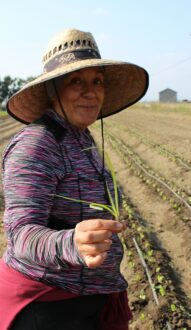La Buena Tierra farmer Maria de los Angeles Carrillo (Angeles) is delighted that her interest in researching a non-chemical pest management practice has reduced her weeds by 80%. Coquillo (nutgrass) was the exception and even that stubborn grass has been reduced greatly and grows weaker roots. Lab tests also demonstrated reduced Verticillium wilt in the soil; crucial as Angeles grows lettuce.
Angeles produces her vegetables using as few chemical inputs as possible, working closely with natural systems. However, on the land in Salinas California that she leases from ALBA she struggled managing weeds and grasses such as purslane, coquillo, pigweed, and lamb’s quarters, among others. While taking classes she learned about solarization - a non-chemical method that captures radiant energy from the sun and uses the heat to manage soilborne pests – as a popular practice by organic farmers in Spain. She first worked on an internship project to learn more about solarization, and then approached Aysha Peterson, Ag Technical Specialist at the Resource Conservation District, Monterey, about conducting further research on her own farm.
With Aysha’s translation assistance and technical guidance, Angeles successfully applied for a Farmer/Rancher grant to lead an on-farm trial to determine the feasibility of using solarization as a pest control for small-scale organic farmers in the California Central Coast region. As the stakeholders for this project are principally the community of small-scale Spanish-speaking organic farmers and the technical assistance providers who support them, a focus of the research looks at the financial difference between farm areas managed with and without solarization.
“For this project, I prepared the soil, bedded it up, and sent soil samples to a lab. I found plastic that lets light through and doesn’t let air and humidity out. The soil temperature never went below 79 degrees, and I also measured the humidity of the soil. I even checked the temperature at night,” says Angeles.
Angeles expected to leave the plastic in place for 6-8 weeks, and to see results in her lettuce crop over the following 3-4 months. By the third week she started checking weed growth and removed the plastic at 7 weeks.
“What I saw was that the weed roots were very weak, and it was easy to pull the purslane.”
Lab results also showed that levels of Verticillium wilt were reduced once the plastic was removed.
Angeles hosted students in ALBA’s PEPA (Farmer Education) program to show them the project, and other farmers in the area ask her questions about her plastic. She will also present her findings at the EcoFarm Conference’s Spanish Language Track.
She’s excited by the results and is excited to experiment more with solarization in the future. From this current project, she learned that it would be better not to make beds as more air got in under the plastic or to find another method to stop oxygen from getting in. She also admits that getting the plastic off can be challenging.
And her next idea is to continue with the solarization but incorporate chicken manure into the compost she applies before placing the plastic. She thinks testing this in winter would be helpful as most seeds and diseases are more dormant during that season. She’d like to get the organic material hot in the winter so that it will kill weeds and diseases when they start emerging.
Angeles has only been farming since 2020 and already she’s showing success in testing new ideas out and improving her land and production. She grew up working her family’s farm in Mexico. Her beginning farm helps her feel connected to her grandparents and her roots and she has strong, solid plans for the future.
“This isn’t a hobby. I want to increase to 5-7 acres and produce food for my local community.”
Note: the interview for this story was conducted in Spanish with assistance from an interpreter.
View Related SARE Grant:
- Evaluating feasibility of solarization for organic small-scale farmers in coastal California (FW23-435)
